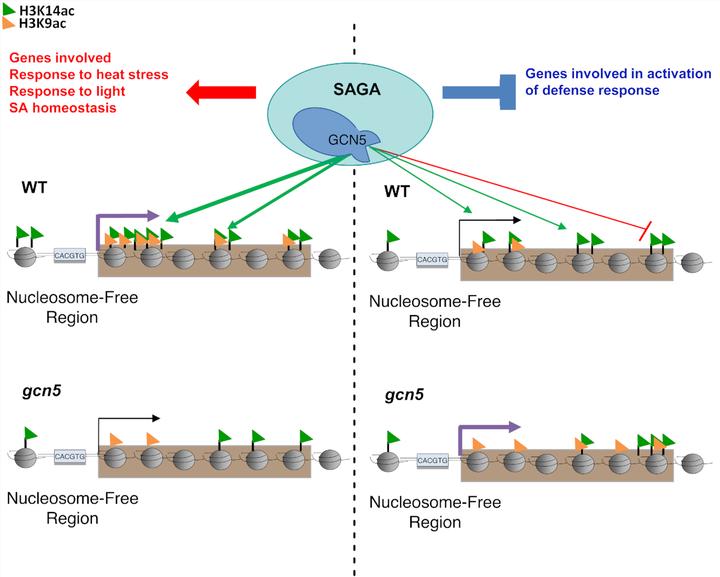GCN5 modulates salicylic acid homeostasis by regulating H3K14ac levels at the 5′ and 3′ ends of its target genes

Abstract
The modification of histones by acetyl groups has a key role in the regulation of chromatin structure and transcription. The Arabidopsis thaliana histone acetyltransferase GCN5 regulates histone modifications as part of the Spt-Ada-Gcn5 Acetyltransferase (SAGA) transcriptional coactivator complex. GCN5 was previously shown to acetylate lysine 14 of histone 3 (H3K14ac) in the promoter regions of its target genes even though GCN5 binding did not systematically correlate with gene activation. Here, we explored the mechanism through which GCN5 controls transcription. First, we fine-mapped its GCN5 binding sites genome-wide and then used several global methodologies (ATAC-seq, ChIP-seq and RNA-seq) to assess the effect of GCN5 loss-of-function on the expression and epigenetic regulation of its target genes. These analyses provided evidence that GCN5 has a dual role in the regulation of H3K14ac levels in their 5′ and 3′ ends of its target genes. While the gcn5 mutation led to a genome-wide decrease of H3K14ac in the 5′ end of the GCN5 down-regulated targets, it also led to an increase of H3K14ac in the 3′ ends of GCN5 up-regulated targets. Furthermore, genome-wide changes in H3K14ac levels in the gcn5 mutant correlated with changes in H3K9ac at both 5′ and 3′ ends, providing evidence for a molecular link between the depositions of these two histone modifications. To understand the biological relevance of these regulations, we showed that GCN5 participates in the responses to biotic stress by repressing salicylic acid (SA) accumulation and SA-mediated immunity, highlighting the role of this protein in the regulation of the crosstalk between diverse developmental and stress-responsive physiological programs. Hence, our results demonstrate that GCN5, through the modulation of H3K14ac levels on its targets, controls the balance between biotic and abiotic stress responses and is a master regulator of plant-environmental interactions.